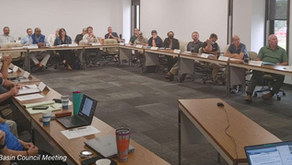Ask the Experts: Improving CMMS and PMIS Systems
- JD Solomon
- Jan 29, 2020
- 3 min read
Updated: Nov 5, 2021

US Coast Guard Electricians Mate Second Class Paul Frantz provided the visual for this month’s topic on Computerized Maintenance Management Systems (CMMS) and Project Management Information Systems (PMIS)
This month’s Ask the Experts is a one-on-one lightning round with longtime colleague Kathryn Benson. Kathryn and I have traveled the United States for more than 15 years doing information management system assessments and implementations.
This conversation focuses on Computerized Maintenance Management Systems (CMMS).
We were pleased to have longtime maintenance and project manager Wayne Littmanmoderate the conversation. Wayne spent more than 40 years in the chemical and pharmaceutical industries working with these types of systems, including developing an internal CMMS manual. Some of Wayne’s Wisdom is provided at the end of the exchange.
- J.D.
What is the top reason that most systems fail?
KB: The end users are not part of the selection process. There has to be end user buy-in for the implementation and improvements to be effective.
JD: I agree and add Organizational Capacity in broader terms. The right people are usually over-taxed with initiatives and there are not enough of them.
KB: In many cases, the current software system will do most of what the organization needs it to do.
JD: Most organizations don’t do the upfront work – many times it is easier to buy new software than spend the time needed to understand the underlying issues.
What aspects need to be considered before selecting a system?
JD: Three things – software, hardware, staff availability.
KB: Staff availability, plus who is the primary business owner of the system, are biggest aspects.
JD: So, we are back to Organizational Capacity.
KB: Yes, the required staff time and a staff leader go hand-in-hand with the system selection decision.
What aspect is most frequently overlooked or undervalued?
KB: Training. The software bells-and-whistles that are sold require well-trained people.
JD: Training is a good one. You can’t have the data quality without the training.
KB: And part of training is also understanding integration with other systems and business processes.
JD: Users understanding of the business processes is often taken for granted and creates bad results.
What single tip would you provide someone that is not happy with their current system?
JD: Do your homework on the current system. Use a formal process to assess what you have.
KB: Part of that assessment needs to be both the software and the current business processes.
JD: Over and over we see this. Organizations just simply don’t know what they have.
KB: That would be my single biggest tip – understand what you have.
Who should lead system selection?
KB: System selection should be a cross-functional team of users.
JD: Yes, and the person on the point has to be someone from Operations & Maintenance function.
KB: It should not be a consultant – it should be a system owner.
JD: And from the ownership organization, it should not be the financial or IT function that leads selection.
Who should lead system implementation?
JD: I’ll stay with the same – the O&M function, who owns the system and must use it every day.
KB: The business owner that will be the tactical leader, normally from the O&M group.
JD: You need consultants to provide the knowledge and time during implementation. The caveat is that they only provide the extra time and resources. The organization and its business owner must lead the implementation.
KB: Too often we simply see the wrong person in charge, and it leads to predictably bad results when the system is in use.
What has surprised you most as you have helped different organizations over the years?
KB: Time and time again it is having the right people in the right place, including have the right people who will make decisions.
JD: It is indeed surprising who leads these efforts. The project leaders need to have both the respect of a cross-functional team and also the ability to make decisions.
KB: Too many organizations think that buying new software will solve their problems.
JD: Much like me thinking a new driver will straighten out my golf swing. It’s a bigger problem than that.
Wayne’s Wisdom
1. You can’t just keep shoving fertilizer at the plants if they don’t want to up-take it.
2. There has to be training to get good data in the system.
3. Watch the quality and procedures. Its natural for everyone to make the system do things the way they prefer rather than working for the best ways to do things.
4. You can’t change the culture in six months – it takes years.
5. The people you start with on the project are usually not all there when you finish it.




Kommentare